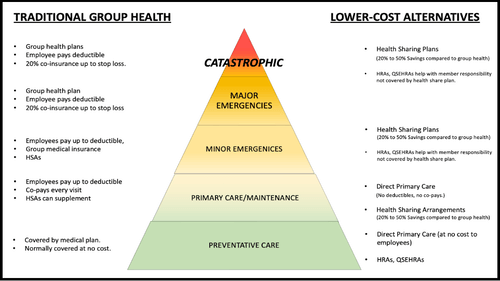In today’s competitive labor market, providing competitive health care for small business while managing costs is critical for attracting and retaining top notch talent.
This blog explores several innovative health care strategies tailored to meet the needs of small businesses with anywhere from 2 to 20 employees.

Health Care for Small Business
Why are innovative solutions for employee health care paramount?
Health insurance ranks as one of the most significant expenses for small businesses, second only to wages and salaries.
According to the Kaiser Family Foundation, the average annual cost of group health insurance premiums per employee stood at $8,435 for single coverage and a hefty $23,968 for family plans in 2022.
This is not sustainable.
But to attract and retain quality employees, you’ve got to offer some form of health benefits. Otherwise, your good employees will quickly leave for another employer who can give them a better deal.
And you’ll be left to try to higher and retrain other employees. If you can attract any at all.
So what is a small business owner to do?
The good news is: You’ve got options.
In addition to costly traditional health insurance solutions, there are several innovative, outside-the-box solutions that are undergoing increasing popularity that help make offering a solid health benefit or set of benefits much more affordable for smaller employers.
These strategies can not only make healthcare protection for your workers more affordable but also potentially cut your current health benefits costs in half.
The Health Care for Small Business Comparison Pyramid
Employees and their families have many different kinds of healthcare needs.
They run the gamut from from small, frequent, routine, predictable, and relatively inexpensive services on one end of the spectrum to severe and catastrophic illnesses and injuries requiring extensive surgery, lengthy hospital stays, trauma care services, and expensive medical equipment that would bankrupt most families many times over.
A good employee health benefit will address each level of the Employee Health Care Pyramid, from the frequent and inexpensive to the infrequent and catastrophically expensive, and leave no gaps.

Traditional group insurance is good at covering major emergencies and catastrophic medical events.
But it is an abject failure when it comes to helping patients with the lower tiers.
That’s because insurance is a risk transfer vehicle. It’s designed to cover infrequent, high-cost events that occur with little predictability. These are called “insurable risks.” The idea is that by paying a premium, the customer transfers risks that they cannot afford to bear as individuals to the insurance company and capital markets, which can.
Frequent and routine costs, such as basic primary care costs, on the other hand, don’t lend themselves to risk transfer. These aren’t risks. These are near certainties.
And so there’s not much risk to transfer. Without risk transference, an insurance company can add little value except to add costs.
Meanwhile, ill-advised regulation and bad legislation have added a mountain of poorly-thought-out additional mandates and costs to traditional insurance companies – driving up premiums but without adding value for most people.
So traditional group health insurance is no longer a cost-effective solution for many small businesses. You should look for alternatives that still deliver solid protection for employees against high unexpected medical costs, but at a lower price.
A comprehensive solution will need to involve multiple approaches, strategies, products, and solutions.
As you can see from this illustration, traditional medical insurance solutions at each level of the Pyramid are listed on the left side of this graphic, while some cost-saving alternatives are on the right.
Medical Cost-Sharing: A Viable and Attractive Alternative to Traditional Health Insurance
Compare Pricing on the Best Insurance Plans Available
Address Each Level of the Health Care for Small Business Comparison Pyramid
A comprehensive employee health benefits package should cover every tier of the Employee Healthcare Pyramid, from preventive care to primary care access and catastrophic incidents.
Non-insurance Alternatives like direct primary care and health sharing can significantly help your bottom line while providing quality care for your team.
You Don’t Have to Offer Traditional Health Insurance
The Affordable Care Act requires employers with 50 or more full-time equivalents to provide health insurance for workers, or pay a significant penalty.
However, if you have fewer than 50 FTEs on the payroll, you are exempt from that requirement. You do not have to offer a traditional health insurance plan at all.
That opens a number of more affordable, cost-effective solutions that are possible for small employers that aren’t available to large employers unless they’re willing to eat the ACA penalty.
Option 1. Drop Group Health and Help Workers Buy Their Own Health Plan via an HRA
Since small employers are exempt from the ACA requirement to offer group health, you could drop your high-cost health plan altogether.
Instead, you could provide workers with the cash to buy their own health insurance plan using a Qualified Small Employer Health Reimbursement Arrangement (QSEHRA).
QSEHRAs are a special type of health reimbursement arrangement (HRA) that allows small employers to help workers pay for their own qualified health insurance plans with tax-free dollars.
HRAs are an attractive alternative to traditional group health insurance. They allow employers to reimburse employees for individual health insurance costs, offering greater flexibility and choice.
Employers are free to choose a health insurance plan that suits their own needs, rather than one their employer chooses for them via a group plan.
All employer contributions to HRAs are tax-deductible, providing savings for both businesses and employees. They’re also tax-free to employees, and not subject to payroll taxes.
You can use your QSEHRA to help your workers pay for their health insurance costs tax-free.
And by dropping your group health insurance plan, you reduce your administrative hassle, risks, and costs associated with group plans.
Option 2. Reduce Barriers to Primary Care Utilization
Chronic and preventable health conditions drive up healthcare expenses and reduce productivity in the workplace.
Studies have repeatedly shown that large numbers of workers skip needed medical care because of costs. Even with insurance. Employees have trouble affording deductibles and copays every time they need to see their primary care physician.
This problem is especially acute with lower-wage workers and households with children. Especially for single parents who only have one income.
Offering easy access to primary care can reduce these costs and improve overall employee productivity.
Most people enrolled in a DPC plan appreciate the short wait times for an appointment, and much longer available appointments face-to-face with their doctors.
This is possible because DPC practices typically don’t take health insurance at all. This allows them to massively reduce administrative overhead, and take on much smaller patient loads.
As a result, doctors have much more time to spend with each patient. Patient satisfaction ratings are extremely high.
Advantages of Direct Primary Care
- Excellent choice for preventive and routine care.
- Comprehensive coverage for individuals with and without pre-existing conditions.
- Pairs well with Health Sharing Plans for well rounded coverage.
Consider offering Direct Primary Care (DPC) as an employee benefit to cover routine doctor visits, checkups, and preventive care at a lower cost for employees.
Note: DPC plans don’t address specialist care, surgeries, hospitalizations, or urgent care needs. So they should not be thought of as a stand-alone solution.
They strictly address the bottom two levels of the Employee Health Care Pyramid, and should be combined with a health insurance or health sharing plan to address the risk of major medical events and catastrophic illnesses and injuries.
Option 3. Switch to Health Sharing Plans
Health sharing plans are quickly becoming a popular, cost-effective non-insurance alternative to overpriced employer group health insurance plans.
These plans typically cost up to 50% less than traditional health insurance.
They also usually offer much more freedom to members to choose their own healthcare providers.
Unlike traditional health insurance plans, however, health sharing plans impose waiting periods for pre-existing conditions. So health sharing plans may not be a suitable solution for everyone.
Consider combining HSPs with HRAs for a more comprehensive approach to employee health benefits.
Why Thousands are Switching from Traditional Health Insurance to Health Sharing Plans
Option 4. Offer Health Savings Accounts and High Deductible Health Plans
Offering High Deductible Health Plans (HDHPs) alongside Health Savings Accounts (HSAs) to your employees can be a strategic and cost-effective healthcare solution for businesses.
HDHPs have lower monthly premiums compared to conventional low-deductible health insurance plans. This can help reduce your company’s healthcare costs while still providing valuable coverage.
By pairing HDHPs with HSAs, you empower your employees to take control of their healthcare expenses.
HSAs offer a unique opportunity for both employers and employees to save on taxes.
Contributions to employees’ HSAs are typically tax-deductible for your business, helping reduce your taxable income. Additionally, HSA contributions are exempt from payroll taxes, such as Social Security and Medicare taxes.
This provides further savings for both your business and your employees. Encouraging contributions to HSAs demonstrates your commitment to their financial well-being and healthcare needs.
Employees can use their HSA funds for qualified medical expenses, including deductibles, copayments, and prescriptions.
By offering HDHPs and contributing to employee HSAs, you provide a valuable benefit that not only reduces healthcare costs but also offers tax advantages, helping your employees secure their financial future.
This approach can attract and retain talent while promoting a culture of financial responsibility within your organization.
Option 5. Combine Multiple Solutions to Health Care for Small Business
Combining multiple benefits and approaches can create multi-layered protection for your employees while keeping costs down.
For instance, offering Direct Primary Care along with a Health Sharing plan covers all levels of the Health Care Pyramid at a much lower cost.
Compare Pricing on the Best HealthShare Plans Available
What To Do Now About Your Health Care for Small Business
If you’re a small business owner, you’ve got enough on your plate.
Health plans are our core competency.
You don’t have to navigate the complex employee benefits industry alone. Our HSA for America Personal Benefits Managers are highly experienced business leaders, many of whom have managed successful companies themselves.
Click here to connect with an expert Personal Benefits Managers to tailor a health benefits plan that suits your unique business needs. It’s easy to get started, and it’s free. You pay nothing for our expertise.
Here are some additional pages related to this article: Boost Your Company’s Benefits Package With a Small Business HSA – A Step-By-Step Guide | How to Combine a DPC Membership with a Health Sharing Plan | Best Health Share Plans Comparison Guide 2024 | Why Smart Small Employers Are Dropping Group Health for ICHRA and DPC | 10 “Must-Have” Employee Benefits You Need To Attract and Retain Top Talent in 2024 | Affordable Health Insurance Plan When You’re Self-Employed
Read More About Group Health Insurance Options in Your State

